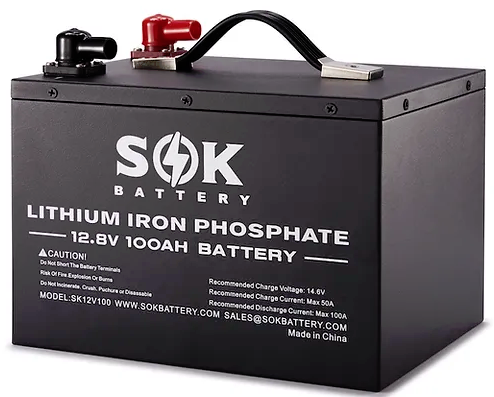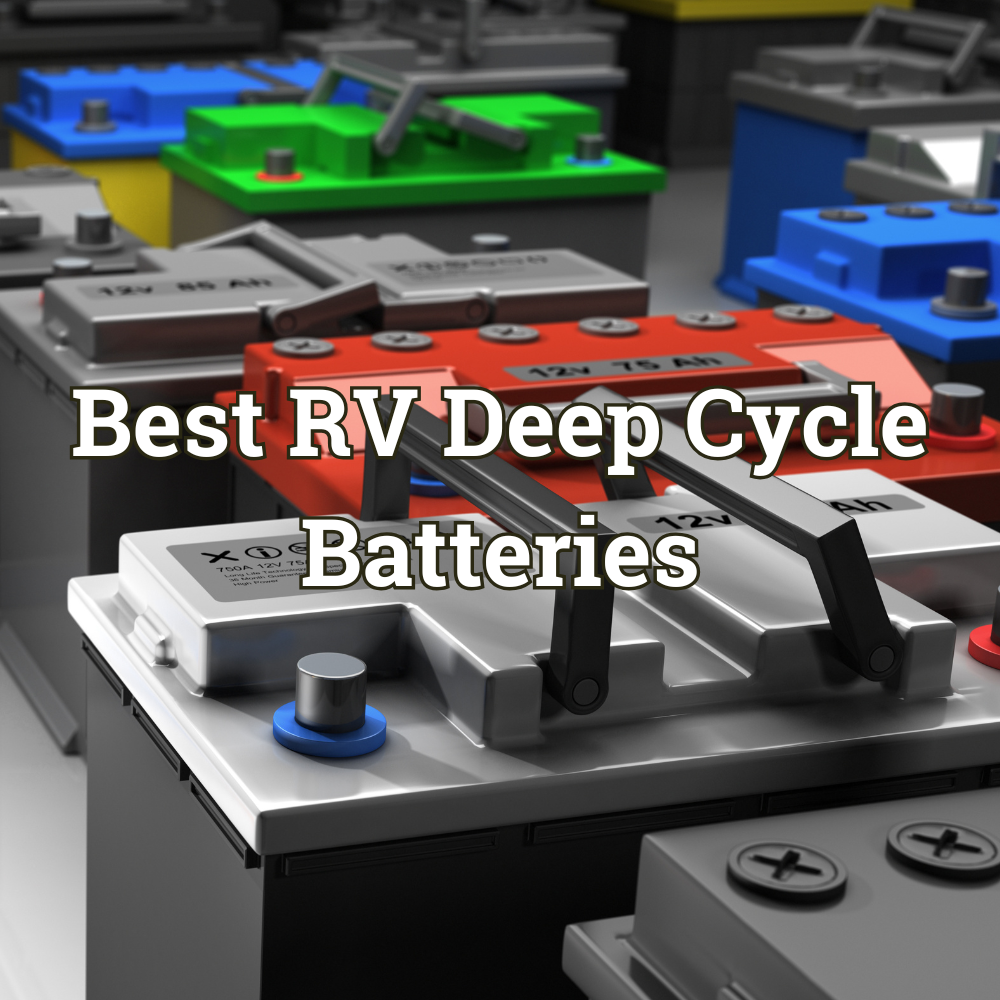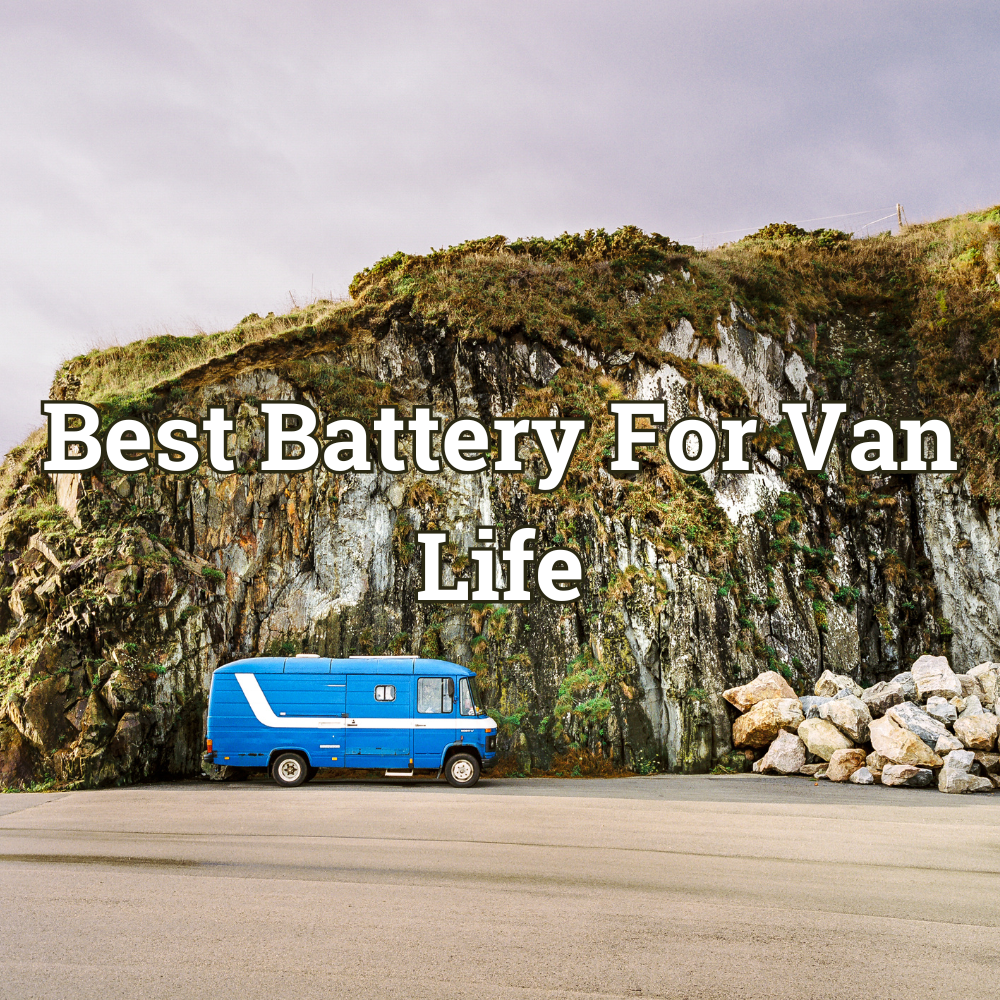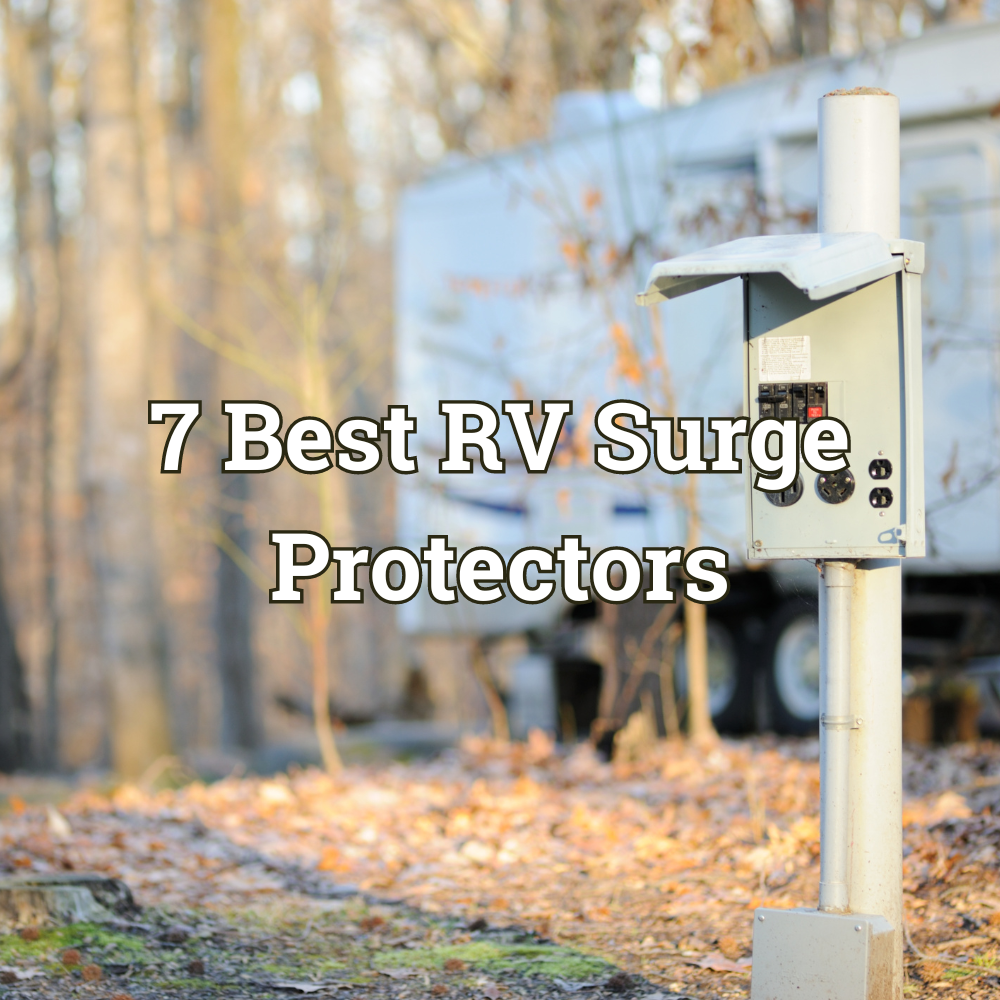Here we’ll take a look at the best battery for RV solar panels, different types of batteries, and provide a brief rundown on some of the best choices of battery for RV solar.
My recommendation would be the SOK 12V 100Ah Lithium Battery.
RV batteries are without doubt one of the best investments you can make as an RVer. A good deep cycle battery can make all the difference to your overall electrical setup, and help you reliably store that precious solar energy.
Contents
A lot has changed in the world of RV batteries in recent years. Advances in technology means that the gap between well known leading brand names and budget brands is closing fast.
There are a handful of budget batteries that are really good quality, and well worth consideration.
Let’s take a look at some of the best RV batteries available.
Best Battery For RV Solar Panels
- SOK 12V100Ah LiFePO4 Battery – Best Overall
- Battleborn Batteries 12V 100Ah Lithium – #2
- Epoch Batteries 12V 100Ah Lithium – #3
- LiTime 12V 100Ah Lithium Battery – Best Budget Lithium
- Renogy AGM 12 Volt 100Ah Battery – Best Deep Cycle AGM
SOK 12.8V 100Ah Lithium Bluetooth Battery
⭐️Best Overall
The SOK lithium is my top choice as a lithium battery. The SOK battery build quality is exceptional for the price.
You can have a maximum of 4 batteries in series or a maximum of 10 in parallel.
The battery internals are fully serviceable via the removable lid. You have access to individual cells and the BMS, which is manufactured by SOK themselves, and replaceable if necessary.
The BMS has over charging and discharging protection, as well as low temperature cut-off. The BMS is particularly good quality and is known for a low failure rate.
The SOK Battery monitoring app can be downloaded and you will get real time feedback and data from the battery. You’ll also get alerts should anything be wrong.
The SOK battery has a 7 year warranty and you will get the benefit of the excellent SOK customer support.
A 12V 206 Ah version of this battery is excellent value for money.
Pros
Bluetooth
Seviceable
High Build Quality
Cons
Widthways Terminals

Overall Rating

Performance / Efficiency

Value For Money

Build Quality

Features / Functions

Reviews

SOK 12.8V 100Ah Battery Specifications
| Voltage | 12.8 Volt – 100 Ah – 1280 Wh |
| Dimensions | L 10.6″ x W 7.9″ x H 8.2″ |
| Weight | 27 lbs |
| Maximum Discharge Current | 170 A |
| Maximum Charge Current | 70 A |
| Cycle Life | 4000 – 8000 Cycles |
Battleborn Batteries 12V 100Ah Lithium
⭐️Choice #2
The Battleborn lithium battery is my second choice as the best battery for RV Solar panels.
Battleborn is an American company that solely makes batteries. They have a proven track record in the industry, and you will be hard pushed to find any dissatisfied customers.
Not only do you get the extra performance, but the Battleborn lithium is ⅕ the weight of a traditional AGM battery.
The battery features a built in BMS, which will protect against short circuit and high and low voltage. The BMS also has a high and low temperature cut-off (protects against damage if charging in freezing temperatures) and automatic cell balancing. There is a heated option for this battery for low temperature charging.
You can mount the batteries in any orientation, and they can be wired in parallel and in series.
The battery has an average lifespan of 10-15 years and you get the benefit of a 10 year warranty and lifetime Battlborn support.
The only drawback to this battery would be the price tag. Although initially expensive, their longevity and performance make them the most cost effective overall.
Pros
Built In BMS
Proven Track Record
10 Year Warranty
Cons
Expensive
Overall Rating

Performance / Efficiency

Value For Money

Build Quality

Features / Functions

Reviews

Battleborn 12V 100Ah Battery Specifications
| Voltage | 12 Volt – 100 Ah – 1200 Wh |
| Dimensions | L 12.76″ x W 6.86″ x H 8.95″ |
| Weight | 31 lbs |
| Maximum Discharge Current | 100 A |
| Maximum Charge Current | 100A |
| Cycle Life | 5000 Cycles @ 80% Depth of Discharge |
Epoch Batteries 12V 100Ah Lithium Battery
⭐️Choice #3
The Epoch lithium battery is a very close runner up to Battleborn on my list.
Epoch are the new kid on the block, and are a division of RoyPow Energy, which in turn are owned by Eve, one the biggest manufacturers of lithium battery cells.
The build quality of the Epoch battery is very high, and access to the internals is easy if servicing is needed.
You can run a maximum of 4 batteries in series or parallel.
This battery has an automatic internal heating system for sub zero charging.
The built in BMS has high and low temperature disconnects, and will also protect against short circuit, overcharge and over discharge.
The Epoch has bluetooth connectivity and you can monitor battery status by downloading the ad free Epoch Batteries app.
The app will give real time data on things like current voltage, cycle count and state of charge. You will also receive fault alerts should any occur.
Epoch also provides an 11 year warranty.
The only mark down for this battery is the length of time on the market. Although a relative newcomer, Epoch has been getting excellent reviews.
Pros
High Build Quality
Lower Price
Bluetooth Connectivity
Cons
New To Market

Overall Rating

Performance / Efficiency

Build Quality

Value For Money

Features / Functions

Reviews

Epoch 12V 100Ah Battery Specifications
| Voltage | 12 Volt – 100 Ah – 1200 Wh |
| Dimensions | L 13.2″ x W 10.22″ x H 10.6″ |
| Weight | 33 lbs |
| Maximum Discharge Current | 120 A |
| Maximum Charge Current | 150 A |
| Cycle Life | 3500 Cycles |
LiTime 12V 100Ah Lithium Battery
⭐️Best Budget Lithium
The LiTime lithium battery is my budget option.
For a budget battery the build quality of the LiTime is very good.
You can wire a maximum of 4 batteries in series and a maximum of 4 in parallel. LiTime states that the batteries can only be mounted in an upright position, although the reason for this hasn’t been made clear.
The battery has an in-built BMS which isn’t generic, and is manufactured by LiTime themselves.
The BMS provides protection against overcharge, over discharge, over current, high temperature and short circuit. Unfortunately, the BMS doesn’t have a low temperature cut-off function.
Although the LiTime does have its drawbacks, you are definitely getting value for money.
The latest version of this battery does have low temperatue protection.
Pros
Affordable
Good Build Quality
Good Customer Support
Cons
No Low Temp Cut-off
Overall Rating

Performance / Efficiency

Value For Money

Build Quality

Features / Functions

Reviews

LiTime 12V 100Ah Battery Specifications
| Voltage | 12 Volt – 100 Ah – 1200 Wh |
| Dimensions | L 13″ x W 6.77″ x H 8.43″ |
| Weight | 24.2 lbs |
| Maximum Discharge Current | 100 A |
| Maximum Charge Current | 50 A |
| Cycle Life | 6000 Cycles @ 80% Depth of Discharge |
Renogy AGM 12 Volt 100Ah Battery
⭐️Best AGM
The Renogy AGM is my choice as an AGM battery.
Although AGM batteries aren’t necessarily the best choice for RV solar, they will work perfectly well.
It’s possible to mount several Renogy AGM batteries in series or up to 4 in parallel.
The Renogy is very well made. It is maintenance free, leakproof and non gassing.
To prolong the battery life as long as possible, it is recommended to only discharge the battery to 50%.
If you are looking for a low cost solution for storing solar energy, then the Renogy battery will do the job.
Pros
Good Build Quality
Affordable
Cons
Low Performance Compared To Lithium
Overall Rating

Performance / Efficiency

Value For Money

Build Quality

Features / Functions

Reviews

Renogy AGM 12 Volt 100Ah Battery Specifications
| Voltage | 12 Volt – 100 Ah – 1200 Wh |
| Dimensions | L 13.1″ x W 6.9″ x H 8.6″ |
| Weight | 62 lbs |
| Maximum Discharge Current | 1100 A (5 Seconds) |
| Maximum Charge Current | 30 A |
| Cycle Life | 600 – 800 Cycles |
AGM vs Lithium Battery For Solar
AGM and Lithium-ion are the main choices for an RV battery.
Although expensive, Lithium is definitely the best battery for RV solar.
AGM batteries will work perfectly well, but their performance capabilities fall well short of modern Lithium-ion batteries.
AGM (Absorbed Glass Mat) Batteries
AGM batteries are the upgraded version of the traditional lead acid battery. The difference being that instead of a liquid, the battery contains a fibreglass matting that is infused with electrolyte. This has many advantages over the traditional lead acid battery.
AGM batteries are sealed, and as a result require no topping up. They are also very tough and durable, and being unaffected by vibration they are an excellent choice as an RV battery. AGM’s are capable of coping with high charge and discharge rates. Depth of discharge (DoD) of lead acid based batteries does vary between manufacturers, with the maximum being around 50%. Most recommend 35% – 40% maximum discharge.
The lifespan of AGM deep cycle batteries is much higher than that of a traditional flooded lead acid battery.
There are many advantages over a traditional battery, but that is reflected in the price. A good quality AGM RV battery will cost at least double the price of a flooded lead acid battery.
Lithium-ion Phosphate (LiFePO4) Batteries
Lithium-ion batteries are the latest in advanced battery technology. Lithium-ion batteries have revolutionised the battery world and work in a different way to traditional lead acid batteries. As a result, they are much lighter and more compact than flooded lead acid and AGM batteries.
They are maintenance free and have an extremely long lifespan. Lithium batteries are also capable of deep discharges (down to 5%) without any damage at all.
Lithium batteries will charge at a much faster rate than both flooded lead acid and AGM, but they will require a battery management system (BMS). N.B. Good quality Lithium RV batteries will have BMS built in to the battery.
The main disadvantage of Lithium-ion batteries is their cost. There is no getting around the fact, good quality Lithium batteries are expensive. Although the initial cost is high, this can be offset by their longevity and excellent performance. In the long run they are the most cost effective choice.
RV Battery Sizes – Volts and Amp Hours (Ah)
Volts, watt-hours (Wh), amps, voltage and amp hours (Ah). It can all get pretty confusing.
Here’s a simple way to look at battery capacity.
How To Work Out Watt-hours
You can judge the capacity of any battery by finding the Watt-hour rating.
Here’s an example:
Your battery has this written on the side: 12 Volt 100 Ah (Amp-hours).
To find the watt-hour rating, simply multiply the two numbers together.
12 Volts x 100 Ah = 1200 Watt-hours.
A 1200 watt-hour battery will run a total of 1200 watts for one hour.
Here are some more examples of what you might find printed on a battery.
12 Volt 125 Ah.
12 Volt x 125 Ah = 1500 Watt-hours
12 Volt 200 Ah.
12 Volt x 200 Ah = 2400 Watt-hours
24 Volt 200 Ah.
24 Volt x 200 Ah = 4800 Watt-hours
There are many combinations, but the watt-hour rating is what you are looking for.
Now all you need to do is estimate the overall watt-hour consumption of all the devices and appliances you would use in your RV, and for how long.
Don’t worry, it’s not as bad as it sounds.
How To Calculate The Watt-hours Of An Appliance.
To work out the watt-hours of an appliance you first need to find the wattage of the appliance or device. This is usually found on a label stuck to the bottom of the appliance.
Then multiply the wattage of the appliance by the number of hours you will use that RV appliance for.
Appliance watts x how many hours a day you use it = daily watt-hours for that appliance.
Here’s an example:
| You have a laptop that is rated at 35 watts. |
| You use the laptop for 2 hours per day. |
| 35 Watts x 2 Hours Per Day = 70 Watt-hours |
If you use an appliance for less than one hour a day, this is how you work it out.
| You have a toaster that is rated at 900 watts. |
| You use the toaster for 9 minutes per day. |
| 900 Watts x 9 minutes Per Day ÷ 60 Minutes = 135 Watt-hours |
So now make an inventory of all the devices and appliances you will use in a 24 hour time period. Use the calculations above to work out the total watt-hour figure of all your appliances and devices you will use in one day.
Now you have this watt-hour figure, you know what the overall capacity of battery bank is needed.
Usable Battery Capacity
It’s important to remember that AGM and Lithium-ion batteries have different usable capacities.
The maximum discharge of an AGM battery will be around 50%, so that will give you 50% usable capacity.
The maximum discharge of a Lithium-ion battery could be 95%, giving you 95% usable capacity.
When doing your calculations, make sure to allow for this.
Examples:
If an AGM battery has a usable capacity of 50% and an overall capacity of 1200 watt-hours.
The 50% usable capacity would be 600 watt-hours.
If a Lithium battery has a usable capacity of 95% and an overall capacity of 1200 watt-hours.
The 95% usable capacity would be 1140 watt-hours.
Your choice of battery will come down to your own usage requirements and personal budget.
Hopefully I’ve provided information that will help you make an informed choice.
My choice: SOK Batteries 12V 100Ah
See how we test and rate products in our reviews here.
Please check out my other equipment reviews.
Recommended reading on mixing AGM and Lithium battery setups: diysolarforum.com
FAQ’s
Can You Mix AGM And Lithium Batteries?
Yes, but with certain conditions. The recommended advice is to add a fuse between different types of battery strings.
Do Lithium Batteries Charge Faster Than Agm?
Yes, Lithium batteries charge much faster than AGM batteries.







